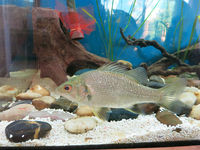Australian Bass (Macquaria novemaculeata)
From The Aquarium Wiki
Australian Bass
Macquaria novemaculeata
568 Litres (150 US G.)
50-60 cm (19.7-23.6")
6.5 - 8.0
15.6-23.9°C (60 -75 °F)
8-12 °d
1:2 M:F
12-20 years
Family
Percichthyidae
Contents
Additional names
- Australian Bass, Freshwater Perch
Additional scientific names
- Dules novemaculeatus, Dules reinhardti, Lates similis
Origin[edit]
- The Australian Bass has been recorded in coastal rivers, lakes and estuaries of eastern and southern Australia. It can also migrate far upstream.
Sexing[edit]
- Males tend to be smaller than females, topping out at around 1 kg maximum. Females on the other hand regularly exceed this and can reach up to 3 kg. Additionally, males reach sexual maturity earlier at around 3–4 years of age while females may reach it at 5–6 years of age.
Tank compatibility[edit]
- Potential predator of smaller fish and inverts, even as a fingerling. Bass adapt well to aquarium life but should be kept in species tanks as an individual or group or with other large fish.
Diet[edit]
- A powerful predator of beetles, moths and other insects, worms, freshwater shrimp, small yabbies and any fish that will fit into the bass' mouth.
- Australian Bass should be fed a varied diet including live insects like crickets from the water's surface and a good portion of other shrimp or insect based food live, frozen and prepared. Good quality Cichlid pellets or Australian native pellets would be an adequate staple for the diet. In salt water they feed on various crustaceans including prawns and small crabs, worms and fish and as such these are suitable for larger bass specimens.
- Piscivory (eating fish) is common in wild specimens as small as 67 mm, but is not common until the fish exceed 100 mm. Natural prey at this size include Australian smelt and flathead gudgeons. The most important food species in wild specimens includes insects, fish and large crustaceans such as freshwater shrimp and yabby. Suitable alternatives for the aquarium would include frequent feeding of live invertebrates such as crickets, moths and other insects, shrimp and yabbies. Occasional live fish may also be fed with caution.
Feeding regime[edit]
- Feed twice daily when water temperatures are warm over 20°C (68°F) , less often in cooler weather as the fish's activity levels reduce significantly in winter. Supplement the diet with plenty of live foods, particularly insects.
Environment specifics[edit]
- Native to cool fresh water rivers of south east Australia. Try to imitate native waterways in the aquarium using rocks, river sand or gravel and driftwood. Adaptable enough for aquariums but also suited to large ponds or dams.
Behaviour[edit]
- Australian Bass are full of personality and become very interactive with their owner, showing great curiosity and confidence even as juveniles. Australian Bass can be somewhat aggressive and territorial fish to their own kind and others. They are also messy fish with a large appetite and as such superb filtration is recommended. They are very hardy fish that can tolerate a range of water conditions.
Identification[edit]
- The Australian Bass is an iconic angling species and can be easily confused with fellow Australian native, the estuary perch. Both share their native region and have a similar body shape, being small to medium fish, but the estuary perch has a longer snout. Australian bass have a somewhat deep body that is laterally compressed. They exhibit a forked caudal fin with strong, sharp spines at the front of their dorsal fins as well as sharp spines on their gill covers. They have a medium sized mouth with a protruding lower jaw and large eyes.
- Australian Bass vary in colour from mustard or gold to bronze or bronze-green colouration. The fish is often a mottled dark olive-green or grey colour on the back and sides. The underside can be silver or cream, and the fins washed out brown or black. Juvenile fish are often banded and have a dark olive-green spot on the gill cover.
Pictures[edit]
External links[edit]
- Fishbase (Mirrors:
 )
)


